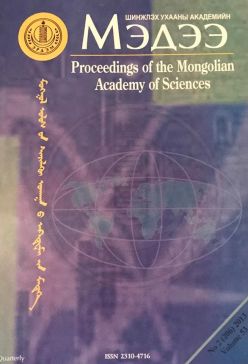Монгол орны хөрс салхиар элэгдэх үйл явцыг үнэлсэн судалгааны үр дүнгээс
DOI:
https://doi.org/10.5564/pmas.v53i206.820Keywords:
гандуу нутаг, хөрс салхиар элэгдэх, гадаргын тэгш бус байдал, бартаа саад, доройтлын зэрэглэл, салхины элэгдлийн тэгшитгэл,Abstract
Phenomenae commonly occuring in arid regions are dust storms. Adaptation mechanism associated with this phenomenon appears in various forms within ecological environments of the world largest desert and semi-deserts. However, due to adverse anthropogenic impacts as well as natural external and internal forces, transportation and accumulation of soil particles by wind intensifies, which accelerates the soil erosion processes in arid territories.
An equation for wind erosion computation used for this assessment was based on the Universal Wind Erosion Equation developed in 1961 by the US Department of Agriculture. When the WEQ equation used for Mongolia, the factors of unsheltered distance or distance for undisturbed wind flowing were not taken into consideration assuming that there is no barrier to hinder the wind force in the given for study area. Meanwhile soil surface was considered as an influencing factor to wind flow and soil surface roughness and obstacles were calculated from the digital elevation data.
The results demonstrate that there is a high degree of wind erosion along the desert zone, Great Lakes Depression, Lakes Valley. Especially soil around the Baruun Khuurain Khotgor, Altai Ovor govi, Ulaan Nuur Lake, Mandal-Ovoo territories have highest degree of wind erosion. Mongolia’s steppe, desert steppe zones, especially steppes of Dornod and areas of Zamyn Uud and Sainshand belong to lands with moderate degree of soil erodibility. Wind erosion changes can clearly be observed in southern part of Govi-Altai, Bayankhongor, Umnugovi aimags, particularly, in valleys and depressions of gobi areas like Sharga, Nomin, Ingen hoovor, Galba, Borzon.
Downloads
1766
Downloads
Published
How to Cite
Issue
Section
License
Copyright on any research article in the Proceedings of the Mongolian Academy of Sciences is retained by the author(s).
The authors grant the Proceedings of the Mongolian Academy of Sciences a license to publish the article and identify itself as the original publisher.

Articles in the Proceedings of the Mongolian Academy of Sciences are Open Access articles published under a Creative Commons Attribution 4.0 International License CC BY.
This license permits use, distribution and reproduction in any medium, provided the original work is properly cited.

